Freshwater prawns (Macrobrachium rosenbergii) are a tropical species of shrimp native to Malaysia (Figure 1). They have been produced in the southern United States since the 1970s. New cultural techniques and management practices for use in temperate climates have dramatically increased the potential for producing prawns commercially in the central United States.
Recent research has been conducted at the Lincoln University George Washington Carver Farm and at the MU Bradford Research and Extension Center to demonstrate that freshwater prawns can successfully and profitably be produced in mid-Missouri. This guide provides research-based information on culture and management techniques that have been successful in producing freshwater prawns and making sound decisions before investing in a prawn production enterprise.
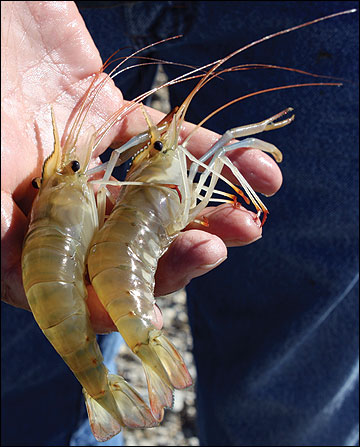 Figure 1. Freshwater prawn production is a viable venture in Missouri thanks to new cultural techniques and management practices.
Figure 1. Freshwater prawn production is a viable venture in Missouri thanks to new cultural techniques and management practices.
Biology and life history
In their native habitats, freshwater prawns require brackish water, and a majority of their life is spent in turbid, riverine systems. The distinct phases of their life cycle include egg, larva, postlarva and adult. Prawns are not tolerant of cold temperatures, so production in more-temperate climates has been limited.
Like other crustaceans, freshwater prawns have a hard outer shell that must be shed regularly to grow. This process is called molting. Because of these periodic molts, growth occurs incrementally rather than continuously.
Females become sexually mature before six months of age. Mating occurs only between hard-shelled males and ripe females that have just completed their premating molt and have soft shells. Within a few hours after mating, eggs are laid and transferred to the underside of the female’s tail, where they are kept aerated and clean. Although first spawns result in only 5,000 to 20,000 eggs per female, mature females have been reported to lay 80,000 to 100,000 eggs during one spawning. The eggs remain attached to the female’s abdomen until they hatch. At 82 degrees F, eggs hatch 20 to 21 days after spawning.
After hatching, larvae are released and swim upside down and tail first. Although larvae can survive for 48 hours in fresh water, for optimum survival they must be transferred to brackish water with a salt content of 9 to 19 parts per thousand. Larvae undergo 11 molts over a period of 15 to 40 days before transforming into the postlarval phase. The rate of this transformation depends upon food quantity and quality, temperature and other water quality variables. Larvae feed primarily on zooplankton and larval stages of aquatic invertebrates.
At this point, prawns will resemble small adults, at about one-third of an inch long, and will number about 50,000 to 76,000 per pound. The diet of the postlarvae expands considerably, and they may become cannibalistic when food is limited. Although no standard definition exists, the term juvenile is used to describe the freshwater prawn between postlarva and adult.
Production techniques
The three defined phases for culturing freshwater prawns are hatchery, nursery and pond grow-out (Table 1). Producers in Missouri contemplating a freshwater shrimp production enterprise should initially forego the hatchery and nursery phase and purchase juveniles from a reliable supplier to stock ponds for grow-out.
In areas of temperate climate such as Missouri, production of freshwater prawns involves stocking juveniles into ponds, followed by a four- to five-month period of grow-out, until they are ready for harvest. The exact grow-out time depends on the range of water temperatures within the growing season, which in most of Missouri is typically from mid- to late-May until mid-October. Stocking juveniles can begin when water temperatures warm up to 68 degrees F.
Water sources with adequate levels of calcium hardness are desirable because calcium is needed for the formation of the exoskeleton. Older juveniles and adults have either a distinctive blue-green color or a brownish hue. Adult males are larger than females, and the sexes are easily distinguishable by examining the prawn’s ventral (bottom) midbody region. In males, the base of the fifth or last pair of walking legs (periopods) is expanded inward to form flaps or clear “bubbles” that cover the openings (gonopores) through which sperm is released. In females, the gap between the last pair of walking legs is much wider, and a genital opening is located at the base of each of the third pair of walking legs. In addition, the second walking legs or claws (chela) and the head region of males are larger than those of the females. Figure 2 shows the external anatomy of a freshwater prawn.
Freshwater prawns develop a social hierarchy based on size and sex. Males maintain a territory with a group of females that are ready for mating. Unless the mature male either dies or molts and returns to a growth phase, the growth potential of the subordinate males will be suppressed. This typically results in three size classes in a pond: large males (blue-claw males), females, and smaller males (orange-claw males). This suppression of growth, when coupled with the physical constraint of how many territories can “fit” in the bottom of a pond, determines the number of pounds of prawns that can be produced.
Successfully producing prawns in ponds during the grow-out phase begins with planning for a water source, pond site selection and pond construction. The production cycle requires prestocking preparation, stocking juveniles, feeding, and managing water quality until harvest.
Table 1. Prawn production cycle.
| Production phase | Life stage | Time of year | Water conditions |
|---|---|---|---|
| Hatchery | Brood-stock (6+ months) | March or earlier | Water temperatures must remain above 70 degrees F |
| Nursery (larvae) | Larval, postlarval | April and May, 15 to 20 days to reach postlarval stage | Will survive best in water with 9 to 19 ppm salt, brackish water |
| Pond grow-out | Juvenile to subadult | May to October, juveniles become bottom dwelling | Fresh water, minimum 5 ppm oxygen, low ammonia levels best for survival |
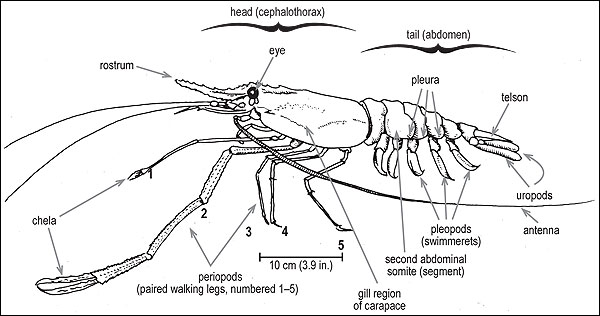
Figure 2. External anatomy of a freshwater prawn.
Site selection
Ponds used for raising freshwater prawns have similar characteristics to ponds used for producing channel catfish and other warm-water aquaculture species. Using a pond designed and constructed specifically for culturing freshwater shrimp, however, will increase the chance of success. Existing ponds constructed for watering livestock or for recreational fishing often are too deep or have existing populations of fish that make them inadequate.
Sites must have good water retention qualities and access to a good supply of fresh water. Avoid sites that are prone to flooding. The soil and water must be free of chemical residues such as organic pesticides that could be harmful to prawns. Collect a soil sample from the pond bottom to determine whether lime is needed. If the pH of the soil is less than 6.5, add agricultural limestone to increase soil pH, preferably to 6.8. Contact your MU Extension center for information on collecting and submitting a soil sample for proper soil fertility recommendations.
Pond construction
A properly designed and constructed pond will greatly enhance the efficiency of prawn harvest and is critical to success (Figure 3). Decide on placement of the harvest basin (internal or external) before starting construction. The depth of the harvest basin and the drainage leaving the basin will determine the overall pond configuration.
A prawn pond should be no more than 3 to 3.5 feet deep at the shallow end, sloping to 4.5 to 5.5 feet at the deep end. This depth will discourage growth of nuisance rooted aquatic weeds and filamentous algae during the growing season and help to keep the water from cooling too rapidly when air temperatures cool in the fall.
The inside slopes of levees generally range from 2-to-1 to 3-to-1. This may vary somewhat due to pond size and soil type. Levee tops that are at least 20 feet wide should be adequate for equipment and management access. Erosion from wind and waves is generally not a problem, as most prawn ponds are smaller than 3 acres; however, 1 foot of freeboard above the water level is recommended.
Bottom contours and drain harvest structures are the most important aspects of pond design because they affect harvest efficiency. The pond bottom should have no obstructions or deep depressions to interfere with the goal of concentrating all prawns into one area during drain harvest. These harvest basins (internal or external) should be designed so that all the pond water drains rapidly into them. Figure 4 shows cross-sectional and overhead views of a pond designed for harvest to an internal harvest basin.
Prawns will naturally follow a flow of water, so drain harvest is a passive yet efficient method for collecting prawns. If a pond is poorly designed, a large number of prawns may be left stranded in muddy depressions and have to be removed manually.
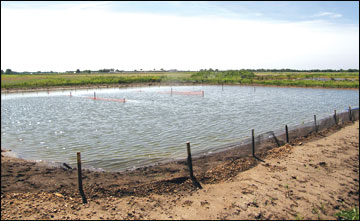 Figure 3. A properly constructed pond can be filled and fertilized so that a phytoplankton bloom is established for zooplankton production well in advance of stocking the juveniles.
Figure 3. A properly constructed pond can be filled and fertilized so that a phytoplankton bloom is established for zooplankton production well in advance of stocking the juveniles.
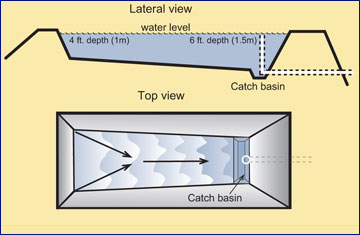 Figure 4. Lateral and top views of a prawn pond with an internal harvest basin.
Figure 4. Lateral and top views of a prawn pond with an internal harvest basin.
Water quality management
The best water supply for freshwater prawn production is from deep wells. Obtaining water from a well allows you to keep topping off water levels in the pond during the growing season to compensate for evaporation. Surface water supplies are less desirable because of the opportunities to introduce disease organisms or other fish that may consume the juvenile prawns.
Water quality parameters for prawns are similar to those for warm-water fish species such as channel catfish and bluegill. Alkalinity, dissolved oxygen, ammonia, pH and nitrite values are particularly important to monitor.
Alkalinity
Freshwater prawns have an exoskeleton, and as they grow, they shed this outside covering and develop a new, larger one. For their exoskeletons to grow at normal rates, prawns need sufficient calcium, which water with an alkalinity level above 50 milligrams per liter will provide. Alkalinity levels above 50 milligrams per liter are also necessary to provide a good buffering capacity, making the water resistant to changes in pH. Alkalinity levels below 50 milligrams per liter do not provide enough calcium and thus restrict growth. In Missouri, most well water contains enough calcium carbonate (CaCO3) to provide alkalinity levels of 50 to 200 milligrams per liter.
Oxygen
For the prawns to survive and thrive, oxygen concentrations should not be allowed to drop below 5 milligrams per liter. Additional aeration should be available to prevent sudden drops in dissolved oxygen due to successive days of cloudy weather or die offs of phytoplankton blooms, or if the pond water becomes inhospitable in the deepest water. Additional aeration will provide the necessary oxygen and circulate the water so that it is uniform throughout the pond.
Ammonia, pH and nitrites
A buildup of ammonia (waste products) can occur during the growing season, especially when feeding is at its highest levels. Growth and survival will be affected by un-ionized ammonia (NH3) levels as low as 0.26 milligrams per liter. Ammonia toxicity is directly affected by the pH and temperature of the water. Higher pH and temperature shifts the ammonia equation to the un-ionized — toxic — form of ammonia. Levels of pH from 6.5 to 9.5 are most desirable. High pH levels, above 9.5 over long periods, will affect growth. High levels of nitrites (NO2-), an intermediate product that results from the breakdown of ammonia, may be toxic to larvae stages of growth during the hatchery phase of production but are not usually a problem during the pond grow-out phase.
Electronic dissolved oxygen meters and chemical water quality kits, available from most aquaculture supply businesses, should be used to establish a consistent water quality-monitoring program. The meters and kits are a minor cost compared to the capital invested in pond construction and juvenile prawns.
Pond preparation and stocking
The success of a prawn production enterprise depends in large part upon the adequate preparation and stocking of the pond. Pond preparation must begin several weeks before stocking the juveniles, and earlier if fish that must be eradicated are present. Ponds should be filled and fertilized about two to three weeks before stocking.
Pond fertilization before stocking
The goal of pond fertilization is to stimulate a phytoplankton algal bloom and a bacterial-based system in the water column. The phytoplankton bloom, in turn, stimulates the production of zooplankton, which is an extremely important food source for the prawns during the first few weeks after stocking (Figure 5). This phytoplankton bloom will also help prevent sunlight from penetrating the water to the pond bottom and prevent the growth of filamentous algae and rooted aquatic vegetation.
Organic or inorganic fertilizers with a nitrogen-phosphate ratio of at least 1-to-3 will be effective to stimulate the bloom. A liquid inorganic fertilizer, either a 10-34-0 or a 13-38-0, should give excellent results. Fertilizer should be added to the pond water at a rate of 1.9 liters (0.5 gallon) per surface acre to stimulate the phytoplankton bloom. Inorganic fertilization is most effective when pond water temperatures exceed 65 degrees F.
Rooted plants or floating filamentous algae (moss) will encourage the growth of undesirable plants, so if they appear, do not apply more inorganic fertilizer. Dense mats of nuisance plants can interfere with later applications of feed and fertilizers, as well as with harvest.
Organic fertilizers that can be used in a prawn pond include distillers dried grains with soluble (DDGS), cottonseed meal, alfalfa meal, soybean meal, sinking catfish feed or combinations of these materials. Make the first application, at a rate of 200 pounds per acre, within a day of filling the pond. Thereafter, apply the chosen fertilizer at a rate of 15 to 20 pounds per acre every other day until stocking to enhance the production of natural food organisms for the prawns.
Research in Missouri has shown excellent survival and production using 200 pounds per acre alfalfa meal and 24 pounds per acre super triple phosphate (a combination of organic and inorganic fertilizer). Once prawns have been stocked, follow the recommendations for organic fertilization (see the Feeds and feeding section). Although alfalfa meal has provided excellent results, the choice of an organic fertilizer can be based on cost and availability. Green manures are not recommended because of the oxygen needed to break them down to a usable form.
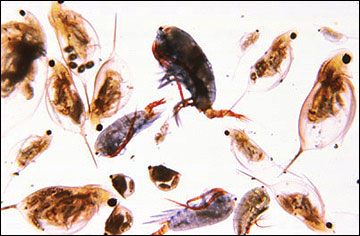 Figure 5. Zooplankton are an important food source for prawns, especially during the first few weeks after stocking.
Figure 5. Zooplankton are an important food source for prawns, especially during the first few weeks after stocking.
Stocking juveniles
Ponds can be stocked with juveniles as soon as early morning water temperatures are consistently above 68 degrees F. Stocking in Missouri can occur from late April through mid-June, depending on the region (Figure 6). Because the growing season in Missouri is limited, only juveniles should be stocked, regardless of stocking density.
To realize the best return for the purchase cost, the average stocking weight of the juveniles should be 0.25 to 0.4 grams (0.009 to 0.014 ounces). In areas of the state with a shorter growing season, the stocking weight should be at the high end of the range. Although smaller juveniles are less expensive, even a small increase in stocking weight can result in a significant increase in production for a 120- to 130-day grow-out season. Juveniles larger than 0.4 grams not only are more expensive but also require larger amounts of water during transportation, and thus increase variable costs and potentially decrease revenues of the enterprise. Sources of juveniles may change, so contact Missouri’s Aquaculture Program (http://mda.mo.gov/abd/aqua) for up-to-date hatchery information.
Before stocking, be sure that the temperature of the pond water is similar to that of the water used during transportation. If the difference is greater than 5 degrees F, gradually acclimate the prawns to the temperature of the pond water. To do this, gradually mix at least 50 percent replacement water with the prawn holding water, allowing about 15 minutes for each degree of temperature increase.
Stocking rates that will provide a marketable prawn after a four- to five-month growing season generally range from 8,000 to 12,000 per acre. Lower stocking densities may yield larger prawns but lower total harvested poundage. Mean individual weight at harvest is inversely proportional to stocking density because individual growth is influenced by the total amount of prawn biomass in the pond. Stocking density will likely be determined by the market and marketing strategies.
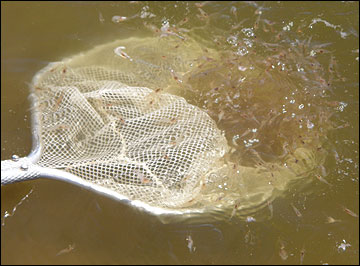 Figure 6. Juvenile prawns can be stocked in fertilized ponds when water temperatures are warm enough in spring.
Figure 6. Juvenile prawns can be stocked in fertilized ponds when water temperatures are warm enough in spring.
Feeding prawns
Like other types of animal agriculture, successful prawn production is dependent on realizing a high-value product (prawns) from low-cost inputs (fertilizer and feed). To achieve maximum growth, prawns must be provided a continuous source of nutrition as economically as possible without being overfed. Juvenile prawns stocked into grow-out ponds can get sufficient nutrition from natural pond organisms. The application of organic fertilizer throughout the growing season will enhance the pond’s natural productivity, so implementation of a fertilizer regimen is necessary to ensure sufficient natural foods (zooplankton, insect larvae and invertebrates) are available.
At higher stocking densities (12,000 or more per acre), however, these levels of organic fertilizers will not produce the quantity of natural food required for maximum prawn growth rate during the growing season. Prawns will need to be fed a water-stable, nutritionally complete, 32 percent protein prawn (shrimp) feed as a supplement.
For best survival and growth, start feeding the second week after stocking, at a rate of 20 to 25 pounds of feed per acre of water surface. Spread the feed over the entire surface because the prawns will be evenly distributed on the pond bottom. Each week, increase the amount of feed fed per day by about 10 pounds, up to a maximum of 60 pounds per acre of water surface.
About 2,000 to 2,500 pounds of feed will be needed during the growing season to produce 1,000 pounds of prawns per acre of water surface.
Recommended feeding rates are estimates that are based on the following factors:
- A feed conversion ratio of 2 to 2.5
- Water temperature
- The total biomass of prawns in the pond, as determined by estimates of individual weights, density and survival
Table 2 provides recommended feeding rates based on estimated survival, estimated consumption expressed as a percent of live body weight, and the mean weight of the population derived from pond sampling.
A proportion of the feed will not be directly consumed by the prawns but rather serves as a source of nutrients for the populations of natural food organisms. A 1 percent mortality within the pond population can be assumed per week; at the end of the pond grow-out season, survival will generally range from 60 to 85 percent when proper water quality is maintained through recommended management practices (see Water quality management section). Yields will typically range from 600 to 1,200 pounds per acre. Mean individual weight is inversely related to production and ranges from 7 to 16 prawns per pound.
Table 2. Weight-dependent feeding rates for semi-intensive pond grow-out of freshwater prawns.
| Mean wet weight (grams)† | Daily feeding rate (percent of body weight fed per day)* |
|---|---|
| < 5 | 0 |
| 5–15 | 7 |
| 15–25 | 5 |
| > 25 | 3 |
†Conversion: 28.35 grams = 1 ounce.
*As-fed weight of diet/wet biomass of prawns x 100.
Harvest
The length of the grow-out phase is significantly different between southern Missouri and central and northern Missouri, and will vary from 110 to 170 days, depending on the latitude of the pond. Harvest should occur when daily water temperatures range from 62 to 68 degrees F four to five days in a row, or before an anticipated cold front may cause lethal water temperatures (below 55 degrees F). In a pond where good water quality management has been practiced, survival may range from 60 to 90 percent at the end of the grow-out season. Yields will typically range from 600 to 1,200 pounds per acre. Weights of prawns will range from 10 to 13 per pound.
Harvest is most efficient in ponds where the water drains down into basins located either within the pond or on the outside of the pond bank. These areas must be well-aerated because the prawns will be concentrated in the basin before being removed. Prawns will follow the movement of the retreating water and usually will not exit the pond until the last flush of water. No one should be in the pond basin during the draining because any activity may cause the prawns to panic and swim upstream into the mud. Drain the pond quickly so the prawn flesh remains fresh.
In ponds without a drain structure, prawns can be harvested by seining, or netting. Seining is more labor-intensive, but it provides an adequate method of harvesting prawns in ponds unsuitable for draining (Figure 7).
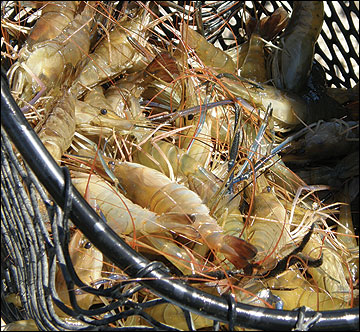 Figure 7. Prawns can be harvested by seining or netting in ponds that cannot be drained.
Figure 7. Prawns can be harvested by seining or netting in ponds that cannot be drained.
Economics
Calculating the costs of production and potential returns is extremely important before investing in a prawn production system. The economics of raising freshwater prawns in temperate climates are quite variable. Fixed costs include land, pond construction and equipment. Annual variable costs include such items as fertilizer, feed, chemicals, juvenile prawns, energy and labor. Weather also plays an important role, as temperatures influence the length of the growing season and can impact profitability.
Table 3 provides estimated variable and fixed costs for a prawn production operation in Missouri. To use this as a model, individual producers will need to insert their actual costs. A stocking rate of 12,000 juveniles per acre was used for this analysis.
Based on a cost of 9 cents each ($90 per 1,000) for juveniles, an average feed conversion ratio of 2 to 2.5 pounds of feed for 1 pound of flesh, an expected average yield of 1,000 pounds of prawns per acre, and a pond bank selling price of $8 per pound, a gross return of $8,000 per acre can be expected. Revenue and profitability, however, depend on the marketing strategy used, as well as other fixed costs and labor costs.
For a thorough economic analysis of freshwater prawn production in temperate climates and more-detailed sample budgets, refer to the Southern Regional Aquaculture Center publication 4830, Economics of Freshwater Prawn Farming in the United States (see references).
Table 3. Estimated annual cost of producing freshwater prawns in a 1-acre pond.*
| Variable costs | |
|---|---|
| Repair and maintenance | $330 |
| Fuel | 120 |
| Electricity | 50 |
| Chemicals (herbicides, fertilizer) | 125 |
| Feed (shrimp feed) | 320 |
| Labor ($10 an hour) | 320 |
| Crushed ice | 50 |
| Transportation | 50 |
| Juveniles (9 cents each; stocking rate 12,000 per acre) | 1,080 |
| Total variable costs | 2,470 |
| Fixed costs (Ownership costs) | |
| Electric aerators | 140 |
| Water pump | 50 |
| Pond construction and collection structure | 500 |
| Total fixed costs | 690 |
| Total costs | 3,160 |
*A seven-year amortization schedule was assumed for calculating fixed costs on an annual basis, and a harvest of 1000 pounds per acre at a market price of $8.00 per pound was assumed. In this scenario, gross revenue = $8,000; net revenue = $4,840. The break-even market price was $4.84 per pound.
Marketing
Seasonal demand for freshwater prawns does exist; however, it is important that your production goals and harvesting practices be developed to coincide with your specific marketing strategy. Financial loss due to lack of demand from live sales and not having adequate storage (holding) facilities can be a reality. Market demand suggests that large, live and iced with heads on freshwater prawns have a lucrative but small niche. A large percentage of markets in Missouri are seasonal and short-term. Most sales result from roadside stands or directly marketing products to restaurants and small grocery stores.
Marketing information and help is available from the Missouri Department of Agriculture’s Aquaculture Program at http://mda.mo.gov/abd/aqua. The program also provides information on beginning an aquaculture business and meeting state and federal regulations.
References and additional information
- D’Abramo, L.R. and M.W. Brunson. Biology and life history of freshwater prawns (PDF). Southern Regional Aquaculture Center (SRAC), Publication No. 483. https://srac.tamu.edu/fact-sheets/serve/132.
- D’Abramo, L.R. and M.W. Brunson. 1996. Production of freshwater prawns in ponds (PDF). Southern Regional Aquaculture Center (SRAC), Publication No. 484. https://srac.tamu.edu/fact-sheets/serve/191.
- Dasgupta, S. 2005. Economics of freshwater prawn farming in the United States (PDF). Southern Regional Aquaculture Center (SRAC), Publication No. 4830. https://srac.tamu.edu/fact-sheets/serve/185.
- Tidwell, J.H. et al. 2002. Freshwater shrimp manual (PDF). Kentucky State University Aquaculture Program. http://www.ksuaquaculture.org/Pubs.htm/ShrimpManual%20text%20Apr2.pdf.
- Tidwell, J.H., L.R. D’Abramo, S.D. Coyle and D. Yasharian. 2005. Overview of recent research and development in temperate culture of the freshwater prawn (Macrobrachium rosenbergii De Man) in the south central United States. Aquaculture Research 36:264–277.